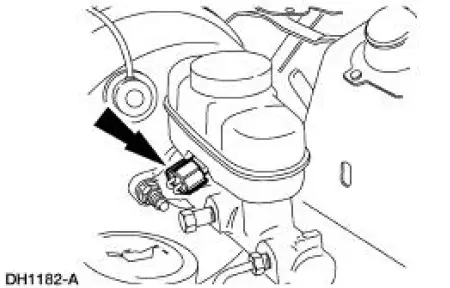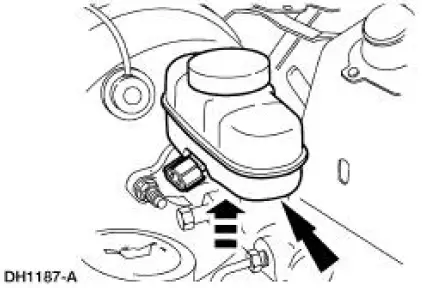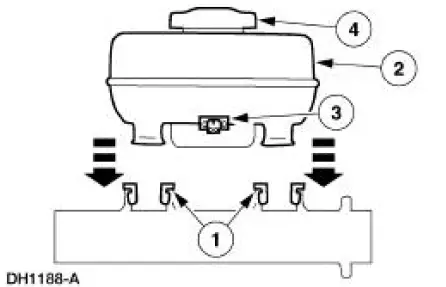Ford Mustang (1999-2004) Service Manual: Reservoir
Removal
WARNING: Brake fluid contains polyglycol ethers and polyglycols. Avoid contact with eyes. Wash hands thoroughly after handling. If brake fluid contacts eyes, flush eyes with running water for 15 minutes. Get medical attention if irritation persists. If taken internally, drink water and induce vomiting. Get medical attention immediately.
1. Disconnect the brake master cylinder fluid level switch.

2. Use a suitable suction device to drain the brake master cylinder reservoir (2K478).
3. Carefully pry up on the brake master cylinder reservoir and remove.

Installation
1. NOTE: Whenever installing a new brake master cylinder reservoir, install new grommets.
Install the brake master cylinder reservoir.
1. Lubricate the two grommets with High Performance DOT 3 Brake Fluid C6AZ-19542-AB or equivalent fluid meeting Ford specification ESA-M6C25-A and insert the grommets into the brake master cylinder (2140).
2. Press the brake master cylinder reservoir into the grommets until it is fully seated.
3. Connect the brake master cylinder fluid level switch.
4. Fill the brake master cylinder reservoir with clean High Performance DOT 3 Brake Fluid C6AZ-19542-AB or equivalent fluid meeting Ford specification ESA-M6C25-A.
5. Bleed the brake master cylinder.

 Master Cylinder - Hydro-Boost
Master Cylinder - Hydro-Boost
Removal
1. Disconnect the fluid level sensor connector.
2. Disconnect the brake tubes.
3. Remove the brake master cylinder nuts.
4. Remove the brake master cylinder (2140).
Installation
1. T ...
 Control Valve
Control Valve
Removal
1. Disconnect the brake tubes.
2. Remove the brake fluid control valve bracket nut.
Installation
1. To install, reverse the removal procedure.
...
Other materials:
Component Tests
Grid Wire Test
1. Using a bright lamp inside the vehicle, inspect the wire grid from
the exterior. A broken grid wire
will appear as a brown spot.
2. Run the engine at idle. Set the rear window defrost switch to ON. The
indicator light should
co ...
Appendices
GENERAL INFORMATION
SYNC® End User License Agreement (EULA)
• You have acquired a device (“DEVICE”) that includes software
licensed by FORD MOTOR COMPANY from an affiliate of Microsoft
Corporation (“MS”). Those installed software products of MS orig ...
Removal
1. Remove the roller followers. For additional information, refer to Roller
Followers in this section.
2. Remove the LH timing chain for the LH side and both timing chains for the RH
side. For
additional information, refer to Timing Drive Components in this ...
